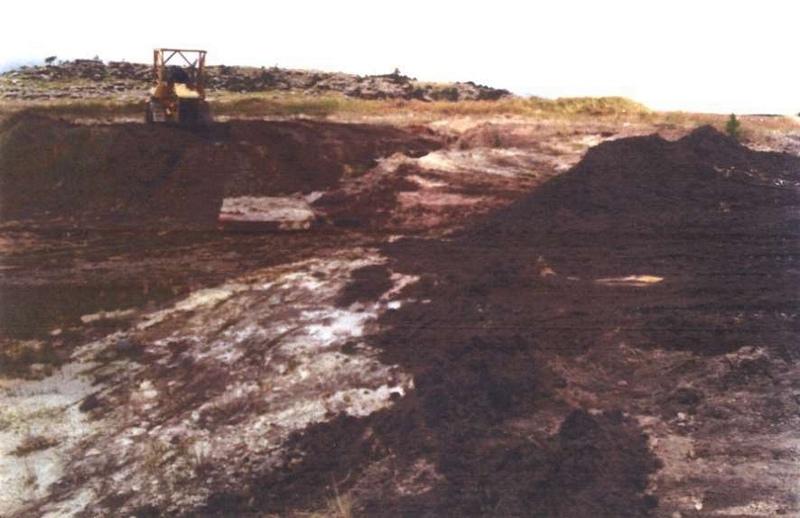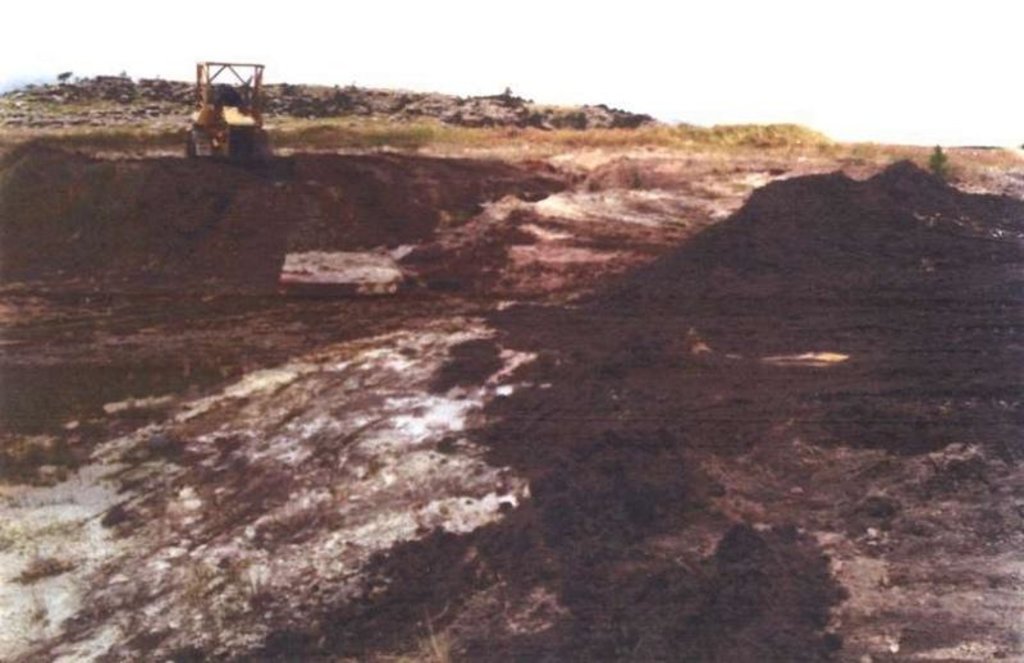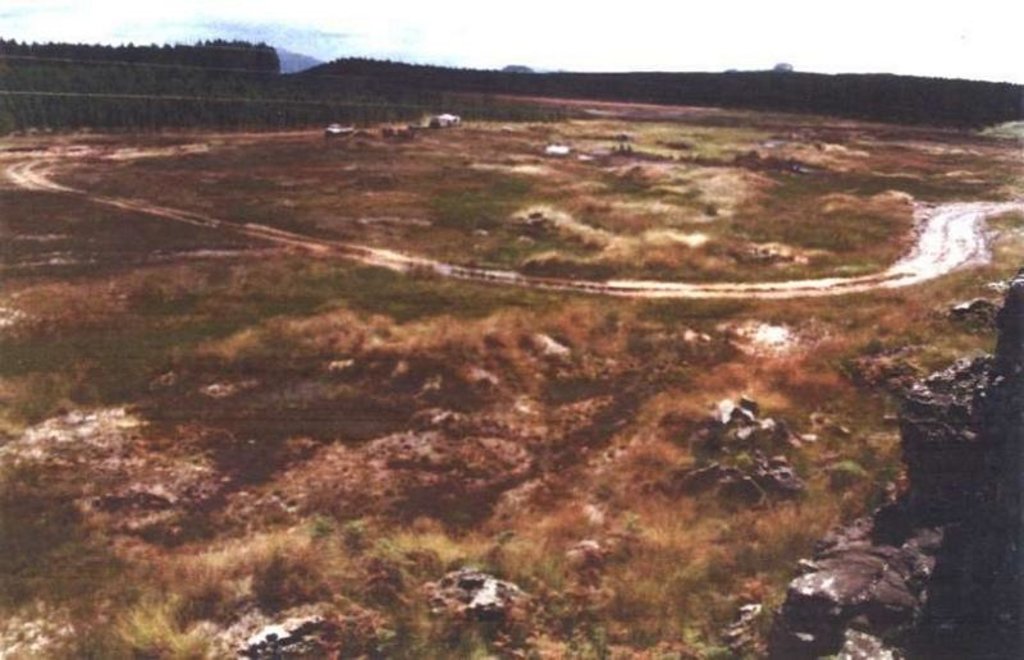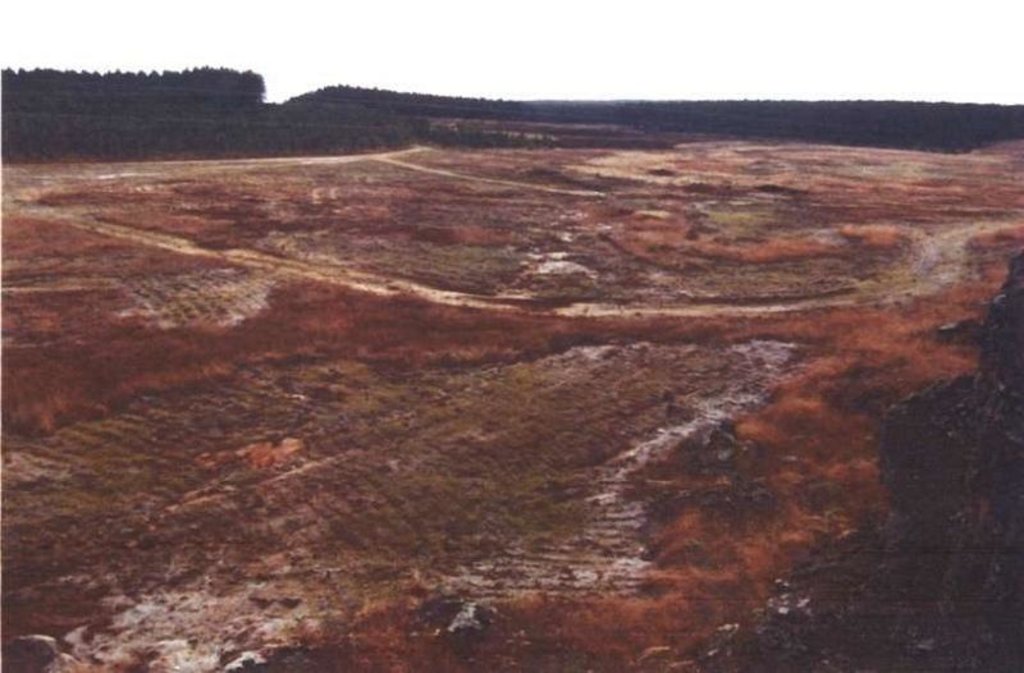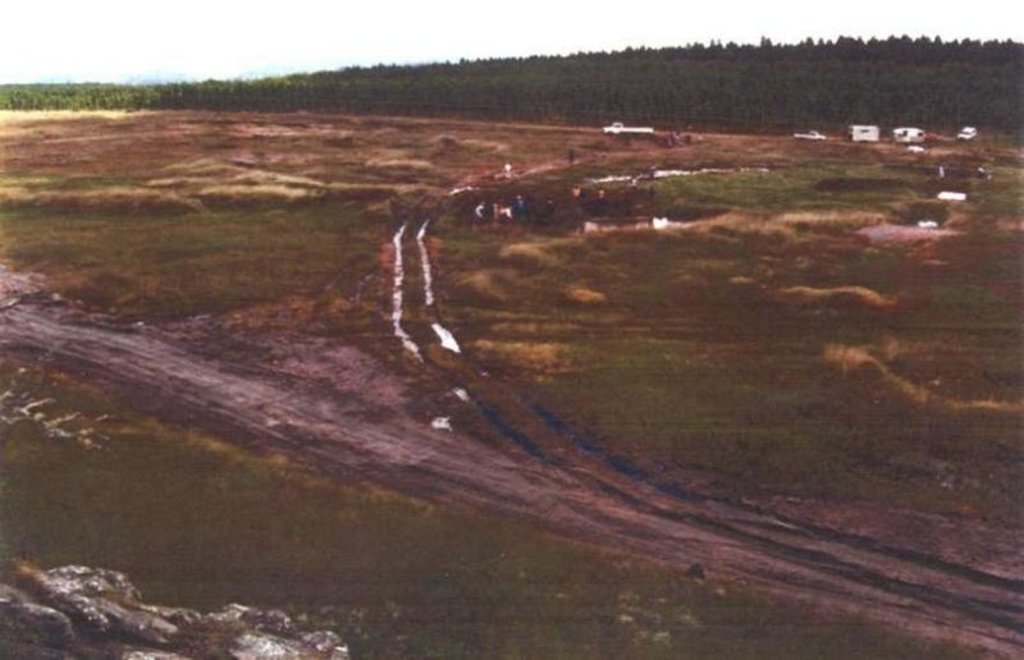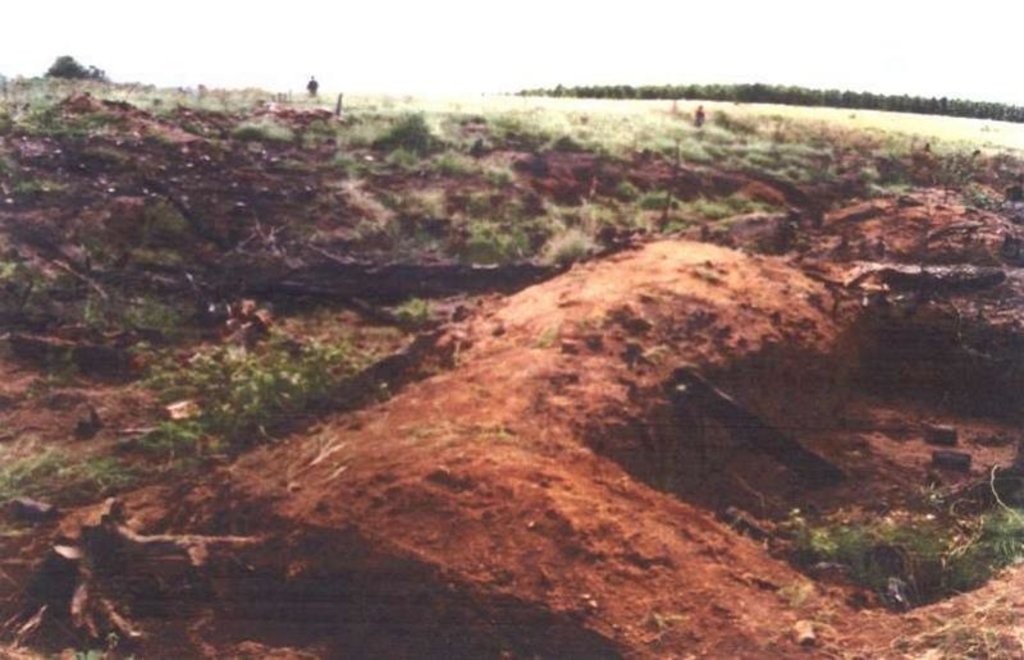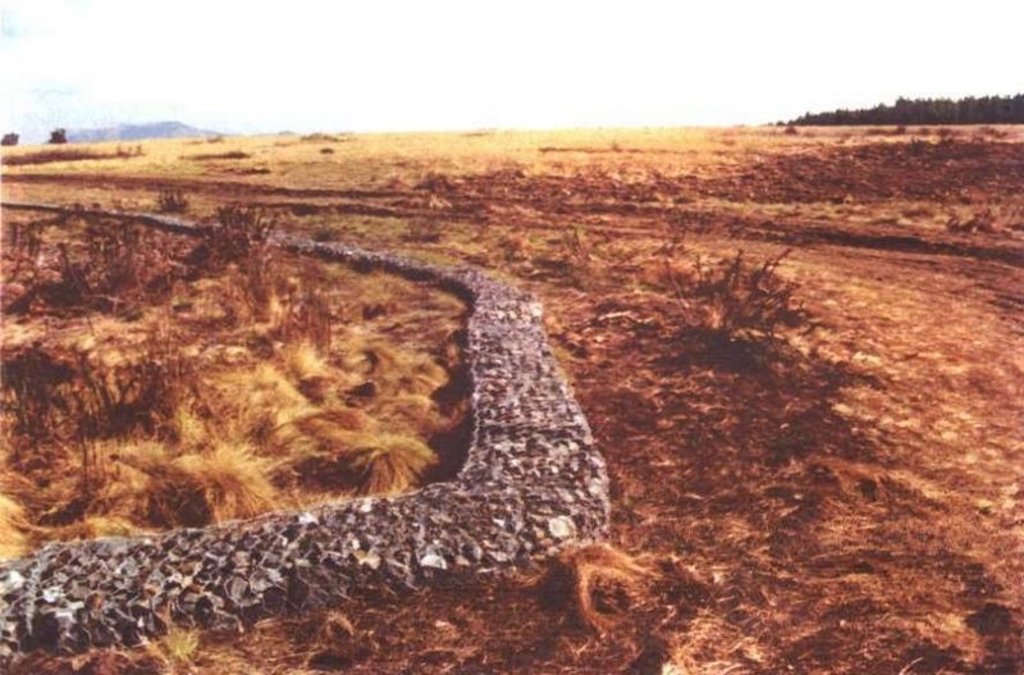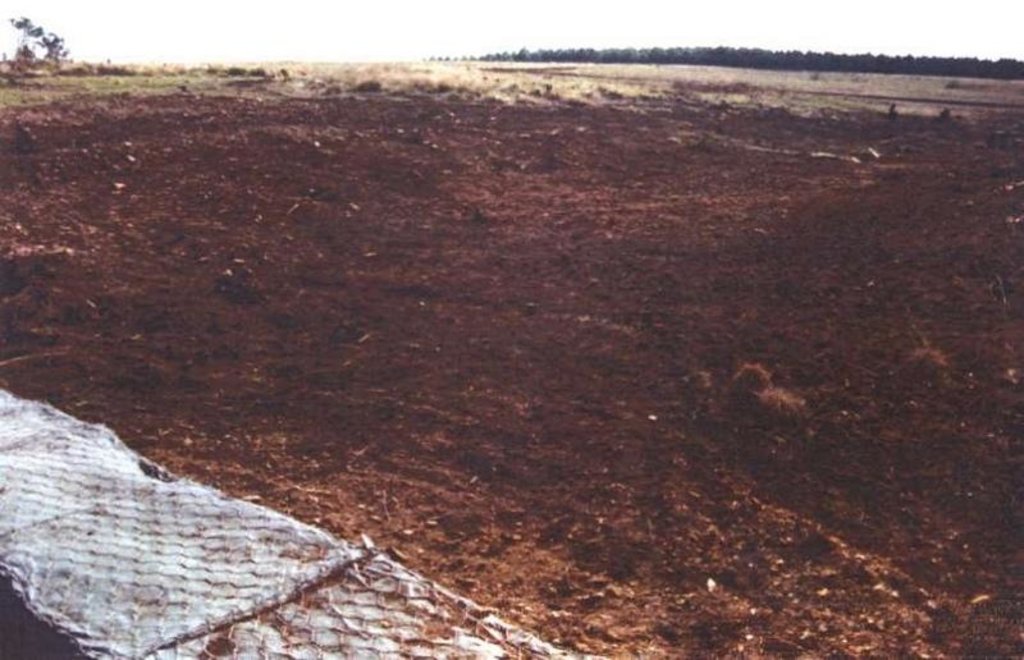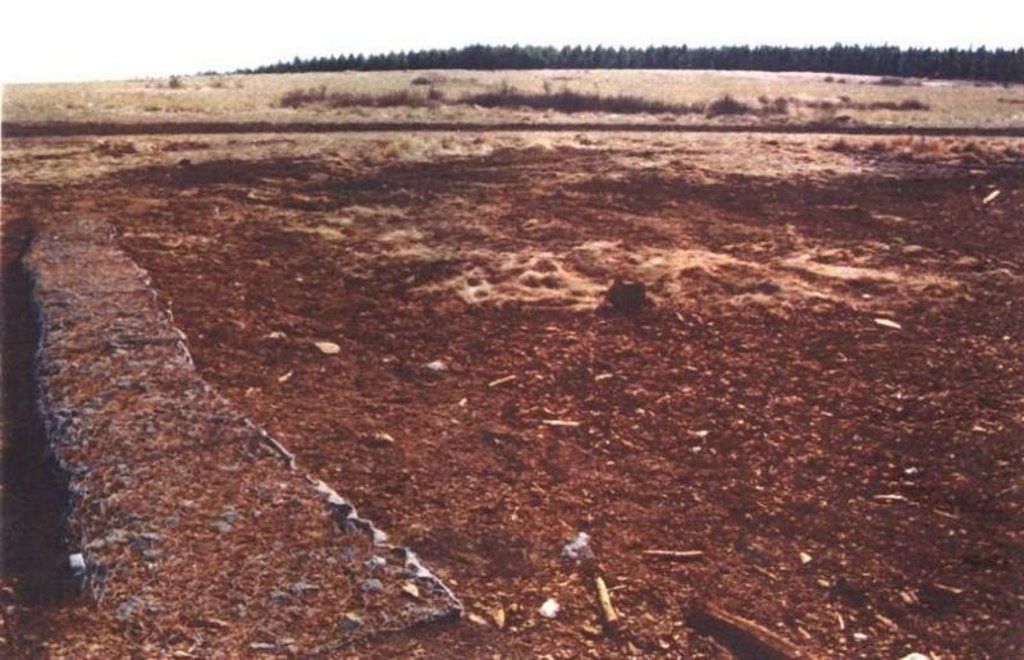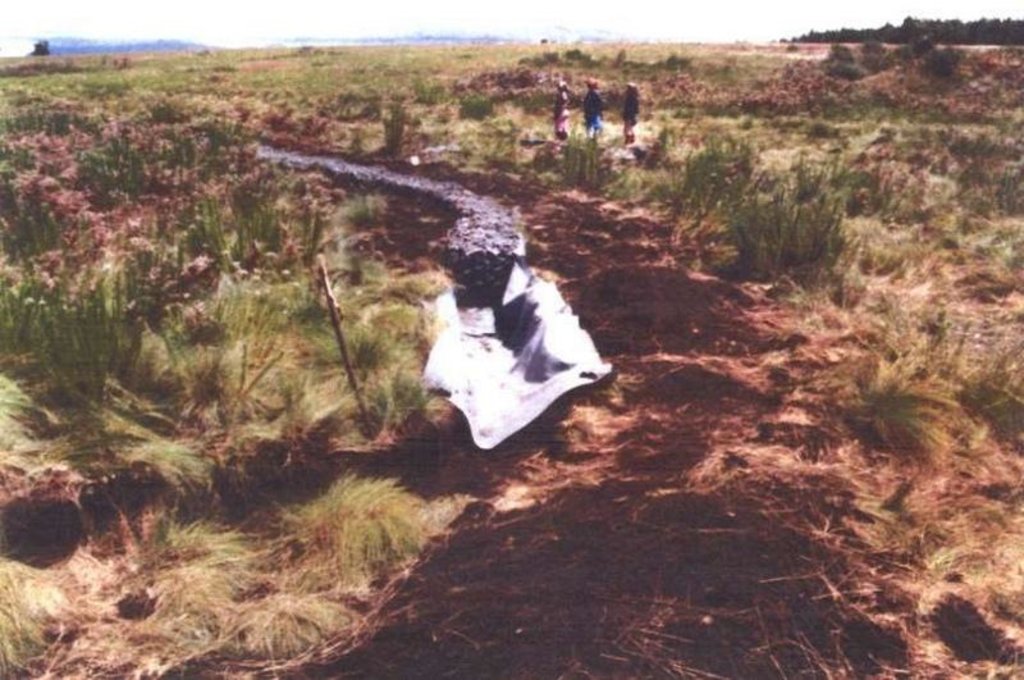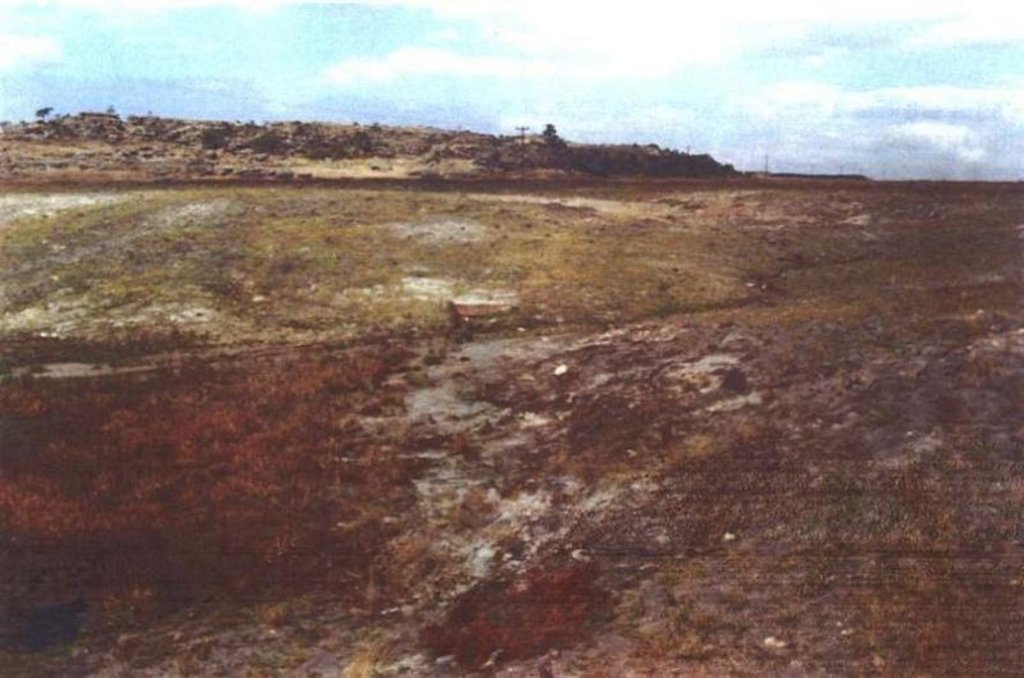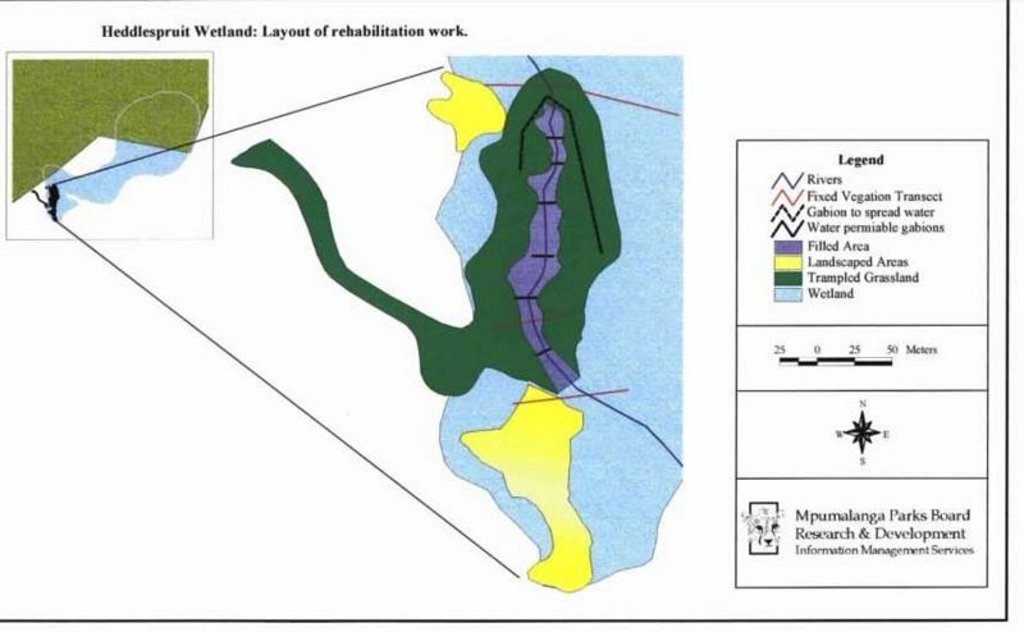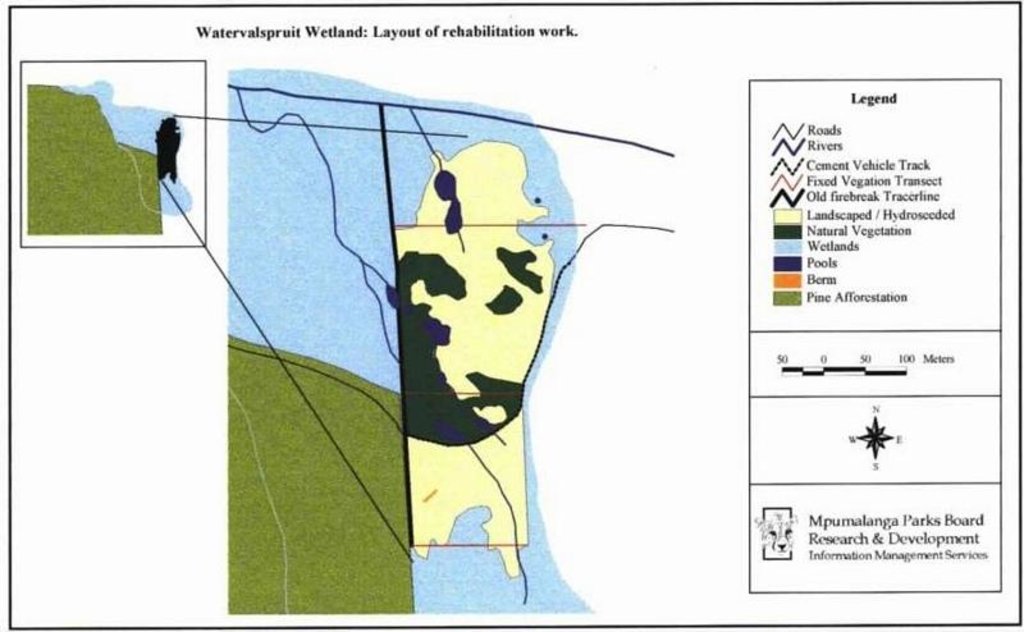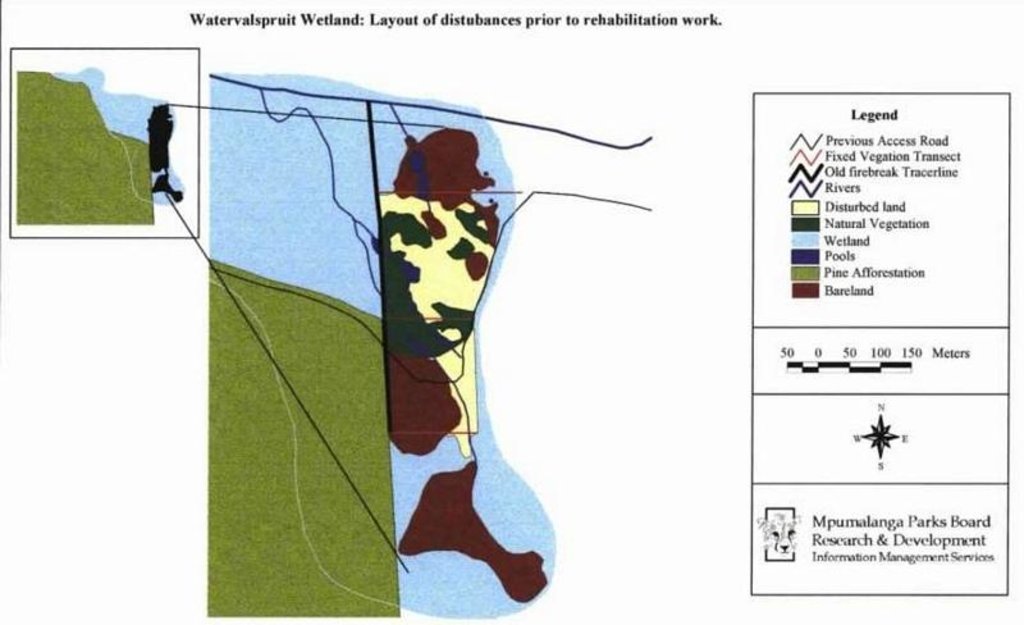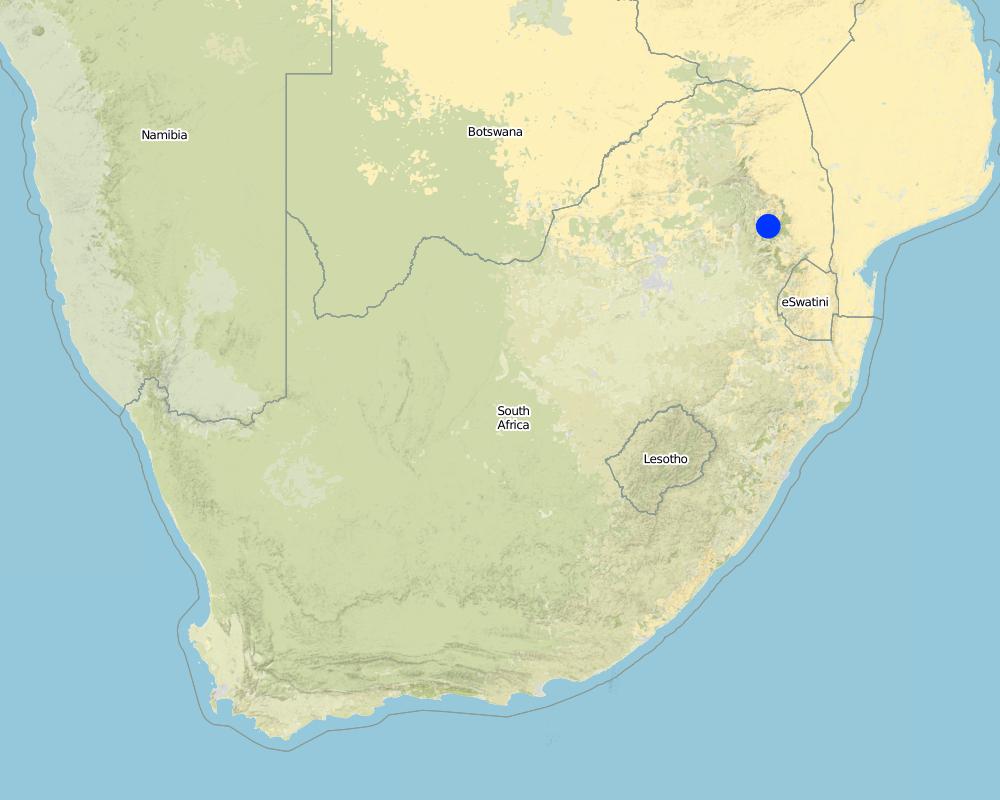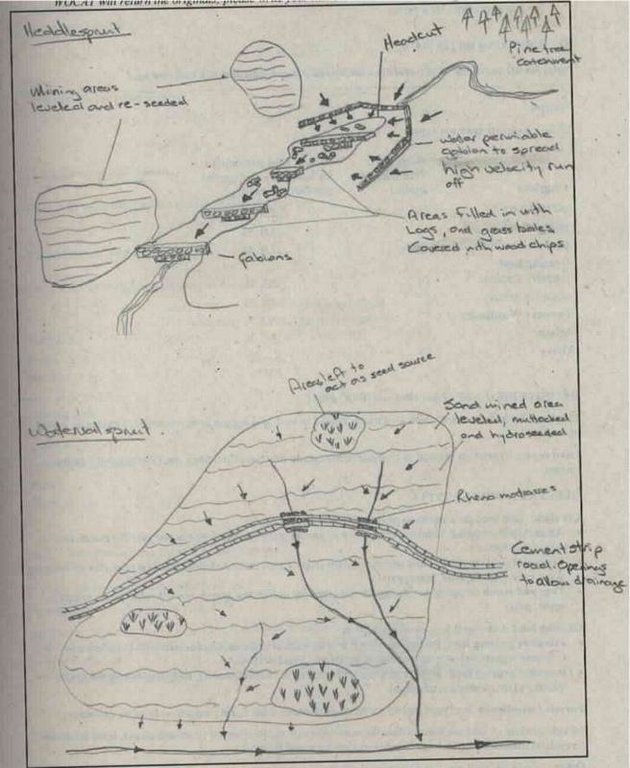Wetland rehabilitation [ប្រទេសអាហ្រ្វិកខាងត្បូង]
- ការបង្កើត៖
- បច្ចុប្បន្នភាព
- អ្នកចងក្រង៖ Unknown User
- អ្នកកែសម្រួល៖ –
- អ្នកត្រួតពិនិត្យច្រើនទៀត៖ David Streiff, Alexandra Gavilano
technologies_1377 - ប្រទេសអាហ្រ្វិកខាងត្បូង
ពិនិត្យមើលគ្រប់ផ្នែក
ពង្រីកមើលទាំងអស់ បង្រួមទាំងអស់1. ព័ត៌មានទូទៅ
1.2 ព័ត៌មានលម្អិតពីបុគ្គលសំខាន់ៗ និងស្ថាប័នដែលចូលរួមក្នុងការវាយតម្លៃ និងចងក្រងឯកសារនៃបច្ចេកទេស
បុគ្គលសំខាន់ម្នាក់ (ច្រើននាក់)
អ្នកជំនាញឯកទេស SLM:
Bronkhorst Frik
Mpumalanga Parks Board
ប្រទេសអាហ្រ្វិកខាងត្បូង
ឈ្មោះអង្គភាពមួយ (ច្រើន) ដែលបានចងក្រងឯកសារ/ វាយតម្លៃបច្ចេកទេស (បើទាក់ទង)
Mpumalanga Tourism and Parks Authority Board (MTPA) - ប្រទេសអាហ្រ្វិកខាងត្បូង1.3 លក្ខខណ្ឌទាក់ទងទៅនឹងការប្រើប្រាស់ទិន្នន័យដែលបានចងក្រងតាមរយៈ វ៉ូខេត
អ្នកចងក្រង និង(បុគ្គលសំខាន់ៗ)យល់ព្រមទទួលយកនូវលក្ខខណ្ឌនានាទាក់ទងទៅនឹងការប្រើប្រាស់ទិន្នន័យដែលបានចងក្រងតាមរយៈវ៉ូខេត:
បាទ/ចា៎
1.5 ការយោងទៅលើកម្រងបញ្ជីសំណួរ (មួយ ឬច្រើន) នៃវិធីសាស្ត្រផ្សព្វផ្សាយ SLM (ដែលបានចងក្រងដោយទស្សនៈពិភពលោកស្តីពីវិធីសាស្ត្រ និងបច្ចេកទេសងអភិរក្ស WOCAT)
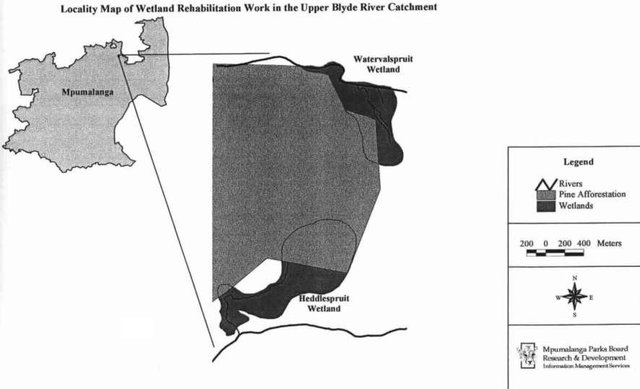
Working for Water Wetland rehabilitation [ប្រទេសអាហ្រ្វិកខាងត្បូង]
To improve the quality & quantity of water production and biodiversity in the Blyde River catchment area.
- អ្នកចងក្រង៖ Unknown User
2. ការពណ៌នាពីបច្ចេកទេស SLM
2.1 ការពណ៌នាដោយសង្ខេបពីបច្ចេកទេស
និយមន័យបច្ចេកទេស:
To rehabilitate/stabilise distorted wetlands as close as possible to its original state/function.
2.2 ការពណ៌នាលម្អិតពីបច្ចេកទេស
ការពណ៌នា:
Two wetland rehabilitation sites that are part of a large wetland area (15 and 10ha).
Purpose of the Technology: The purpose of the rehabilitation work was to stabilise, landscape and re-vegetate distorted areas to again fulfil their original function in the catchment.
Establishment / maintenance activities and inputs: Maintenance included follow-up on re-seeding distorted areas and alien plant control (cut down plants and treads strips with roundup). Structure maintenance (such as gabions, roads) is also done.
Fire management to protect and manage the area of rehabilitation until such time as it has proved to be stabilised. Leave for ± 3 years before considering burning.
2.3 រូបភាពនៃបច្ចេកទេស
2.5 ប្រទេស/តំបន់/ទីតាំងកន្លែង ដែលបច្ចេកទេសត្រូវបានអនុវត្ត និងបានគ្រប់ដណ្តប់ដោយការវាយតម្លៃនេះ
ប្រទេស:
ប្រទេសអាហ្រ្វិកខាងត្បូង
តំបន់/រដ្ឋ/ខេត្ត:
Mpumalanga
បញ្ជាក់បន្ថែមពីលក្ខណៈនៃទីតាំង:
Mpumalanga
បញ្ជាក់ពីការសាយភាយនៃបច្ចេកទេស:
- ត្រូវបានផ្សព្វផ្សាយត្រឹមតំបន់មួយ
ប្រសិនបើបច្ចេកទេសត្រូវបានសាយភាយពាសពេញតំបន់ណាមួយ បញ្ជាក់ទំហំផ្ទៃដីអនុវត្តន៍ (គិតជា គ.ម2):
0,3
ប្រសិនបើមិនច្បាស់ពីទំហំផ្ទៃដី សូមធ្វើការប៉ាន់ប្រម៉ាណ:
- 0.1-1 គម2
មតិយោបល់:
Total area covered by the SLM Technology is 0.3 km2.
Wetland rehabilitation work has been executed on two wetlands in the upper catchment of the Blyde River in Mpumalanga.
Map
×2.6 កាលបរិច្ឆេទនៃការអនុវត្ត
ប្រសិនបើមិនច្បាស់ឆ្នាំ សូមបញ្ជាក់កាលបរិច្ឆេទដែលប្រហាក់ប្រហែល:
- តិចជាង 10ឆ្នាំមុន (ថ្មី)
2.7 ការណែនាំពីបច្ចេកទេស
សូមបញ្ជាក់តើបច្ចេកទេសត្រូវបានណែនាំឱ្យអនុវត្តដោយរបៀបណា:
- តាមរយៈគម្រោង / អន្តរាគមន៍ពីខាងក្រៅ
មតិយោបល់ (ប្រភេទនៃគម្រោង ។ល។):
Subjective inputs/discussions with specialists in variety of disciplines (scientist, botanists, hydrologists, managers, ecologists)
3. ចំណាត់ថ្នាក់នៃបច្ចេកទេស SLM
3.1 គោលបំណងចម្បង (១ ឬច្រើន) នៃបច្ចេកទេសនេះ
- អភិរក្សប្រព័ន្ធអេកូឡូស៊ី
3.2 ប្រភេទដីប្រើប្រាស់មួយប្រភេទ (ច្រើនប្រភេទ) ដែលបានអនុវត្តបច្ចេកទេស

ដីសម្រាប់ចិញ្ចឹមសត្វ
វាលស្មៅធំៗ:
- បែងចែកវាលស្មៅជាប្លុក
- game
មតិយោបល់:
Major land use problems (compiler’s opinion): Afforestation: Pine plantations destroys diversity, also has a major effect on quality & quantity of water run-off, mining opencast activities
Major land use problems (land users’ perception): Production of wood/timber, job creation
Ranching: Game occur natural in this area/nature reserve
Grazingland comments: Area in which these two wetlands are situated is proclaimed conservation land. The aim is to manage the area in an as natural as possible condition as it was historically.
Type of grazing system comments: Area in which these two wetlands are situated is proclaimed conservation land. The aim is to manage the area in an as natural as possible condition as it was historically.
Constraints of nature reserve: Fire management/adjacent to pine plantations
Longest growing period in days: 240; Longest growing period from month to month: Oct - May
3.5 ក្រុម SLM ដែលបច្ចេកទេសស្ថិតនៅក្នុង
- តំបន់ទ្រនាប់ (បិទការប្រើប្រាស់ គាំទ្រដល់ការស្តារឡើងវិញ)
- ការគ្រប់គ្រង/ ការការពារតំបន់ដីសើម
3.6 វិធានការ SLM ដែលបញ្ចូលនូវបច្ចេកទេស

វិធានការក្សេត្រសាស្ត្រ

វិធានការរុក្ខជាតិ

វិធានការរចនាស័ម្ពន្ធ
មតិយោបល់:
Main measures: vegetative measures, structural measures, management measures
3.7 កំណត់ប្រភេទនៃការធ្លាក់ចុះគុណភាពដីសំខាន់ៗដែលបច្ចេកទេសនេះបានដោះស្រាយ

ការហូរច្រោះដីដោយសារទឹក
- Wt: ការបាត់ដីស្រទាប់លើដោយការហូរច្រោះ

ការបាត់បង់រូបសាស្ត្រនៃដី
- Pu: បាត់បង់នូវផលិតភាពជីវៈដោយសារសកម្មភាពផ្សេងៗ

ការបាត់បង់ទឹក
- Ha: ការថយចុះសំណើមដី
មតិយោបល់:
Main causes of degradation: industrial activities and mining, education, access to knowledge and support services (Mineral affairs don’t inspect and allows anything.), Lack of enforcement of legislat./authority (2.1.3.2 Government has not enough authority), Mining
Secondary causes of degradation: Forestry
3.8 ការពារ កាត់បន្ថយ ឬស្តារឡើងវិញនៃការធ្លាក់ចុះគុណភាពដី
បញ្ជាក់ពីគោលដៅរបស់បច្ចេកទេស ដែលផ្តោតទៅការធ្លាក់ចុះគុណភាពដី:
- ការជួសជុល/ ស្តារឡើងវិញនៃឱនភាពដីធ្ងន់ធ្ងរ
4. បច្ចេកទេសជាក់លាក់ សកម្មភាពអនុវត្ត ធាតុចូល និងថ្លៃដើម
4.1 គំនូសបច្ចេកទេសនៃបច្ចេកទេសនេះ
លក្ខណៈពិសេសនៃបច្ចេកទេស (ទាក់ទងនឺងគំនូរបច្ចេកទេស):
Wetland rehabilitation
Location: Blyde canyon. Mpumalanga
Technical knowledge required for field staff / advisors: high
Technical knowledge required for land users: moderate
Main technical functions: control of raindrop splash, control of dispersed runoff: retain / trap, control of concentrated runoff: retain / trap, improvement of ground cover, increase of infiltration, increase / maintain water stored in soil, control of fires, fire management
Secondary technical functions: control of concentrated runoff: drain / divert, reduction of slope length, increase of surface roughness, increase in organic matter, water spreading, increase in soil fertility
Vegetative measure: contour
Vegetative material: G : grass
Vertical interval between rows / strips / blocks (m): 0.1
Spacing between rows / strips / blocks (m): 0.5
Vegetative measure: graded strips
Vegetative material: G : grass
Vegetative measure: Vegetative material: G : grass
Grass species: Eragrostis, Stiburus, Cynodon
Gradient along the rows / strips: 3.00%
Diversion ditch/ drainage
Height of bunds/banks/others (m): 0.5
Width of bunds/banks/others (m): 0.5
Length of bunds/banks/others (m): 60
Structural measure: road
Depth of ditches/pits/dams (m): 0.15
Width of ditches/pits/dams (m): 0.5
Length of ditches/pits/dams (m): 120
Structural measure: filling heddle
Structural measure: bunds/banks: contour
Vertical interval between structures (m): 0.15
Spacing between structures (m): 0.15
Construction material (earth): Contour muttrocking
Construction material (stone): At Heddlespruit: gabions & stonewall to spread high velocity runoff
Construction material (concrete): Strip road with 1m interval openings to allow for draining
Construction material (other): Heddle filling: pine logs, hay bales, wood chips
Vegetation is used for stabilisation of structures.
Other type of management: Fire management
ឈ្មោះអ្នកនិពន្ធ:
Frik Bronkhorst
4.2 ព័ត៌មានទូទៅដែលពាក់ព័ន្ធនឹងការគណនាធាតុចូល និងថ្លៃដើម
ផ្សេងៗ/ រូបិយប័ណ្ណជាតិ (បញ្ជាក់):
rand
បើពាក់ព័ន្ធសូមកំណត់អត្រាប្តូរប្រាក់ពីដុល្លាទៅរូបិយប័ណ្ណតំបន់ (ឧ. 1 ដុល្លារ = 79.9 រៀលនៃរូបិយប័ណ្ណប្រេស៊ីល) ៖ 1 ដុល្លារ =:
8,0
កំណត់ថ្លៃឈ្នួលជាមធ្យមនៃការជួលកម្លាំងពលកម្មក្នុងមួយថ្ងៃ:
4.00
4.3 សកម្មភាពបង្កើត
| សកម្មភាព | រយៈពេល (រដូវកាល) | |
|---|---|---|
| 1. | Hydro-seeding | Directly after landscaping/levelling |
| 2. | Hand seeding | Directly after landscaping/levelling |
| 3. | Harvesting & replanting of vlei grass | Directly after landscaping/levelling |
| 4. | Scarifying forming | Directly after landscaping/levelling |
| 5. | Horizontal chills | Directly after landscaping/levelling |
| 6. | Gabion building | March |
| 7. | Landscaping | March |
| 8. | Muttrocking | April |
| 9. | Replanting grasses | April |
| 10. | Hydroseeding | April/May |
| 11. | Tracers and firebreaks (to secure rehabilitation work) | Autumn/winter |
4.4 ថ្លៃដើម និងធាតុចូលដែលត្រូវការសម្រាប់ការបង្កើតបច្ចេកទេស
| បញ្ជាក់ពីធាតុចូល | ឯកតា | បរិមាណ | ថ្លៃដើមក្នុងមួយឯកតា | ថ្លៃធាតុចូលសរុប | % នៃថ្លៃដើមដែលចំណាយដោយអ្នកប្រើប្រាស់ដី | |
|---|---|---|---|---|---|---|
| កម្លាំងពលកម្ម | Rehabilitate wetland | ha | 1,0 | 56000,0 | 56000,0 | 80,0 |
| ថ្លៃដើមសរុបក្នុងការបង្កើតបច្ចេកទេស | 56000,0 | |||||
| ថ្លៃដើមសរុបក្នុងការបង្កើតបច្ចេកទេសគិតជាដុល្លារ | 7000,0 | |||||
មតិយោបល់:
Duration of establishment phase: 12 month(s)
4.5 សកម្មភាពថែទាំ
| សកម្មភាព | ពេលវេលា/ ភាពញឹកញាប់ | |
|---|---|---|
| 1. | Fire protection | June /Once a year |
| 2. | Gabion maintenance | /Ad hoc |
| 3. | Hydroseeding | September/Once |
| 4. | Gabion maintenance | Ad hoc/Ad hoc |
| 5. | Road maintenance | Ad hoc/Ad hoc |
| 6. | Tracers & firebreaks | Autumn / Annual |
4.7 កត្តាសំខាន់បំផុតដែលមានឥទ្ធិពលដល់ការចំណាយ
ពណ៌នាពីកត្តាប៉ះពាល់ចម្បងៗទៅលើថ្លៃដើម:
Labour: By using machinery where applicable, work can be done less expensive.
Weather conditions: High rainfall areas, delays work, can destroy half done/partially done processes.
5. លក្ខណៈបរិស្ថានធម្មជាតិ និងមនុស្ស
5.1 អាកាសធាតុ
បរិមាណទឹកភ្លៀងប្រចាំឆ្នាំ
- < 250 មម
- 251-500 មម
- 501-750 មម
- 751-1,000 មម
- 1,001-1,500 មម
- 1,501-2,000 មម
- 2,001-3,000 មម
- 3,001-4,000 មម
- > 4,000 មម
កំណត់បរិមាណទឹកភ្លៀង (បើដឹង) ជា មីលីម៉ែត្រ:
2500,00
តំបន់កសិអាកាសធាតុ
- សើម
5.2 សណ្ឋានដី
ជម្រាលជាមធ្យម:
- រាបស្មើ (0-2%)
- ជម្រាលតិចតួច (3-5%)
- មធ្យម (6-10%)
- ជម្រាលខ្ពស់បន្តិច (11-15%)
- ទីទួល (16-30%)
- ទីទួលចោត (31-60%)
- ទីទួលចោតខ្លាំង (>60%)
ទម្រង់ដី:
- ខ្ពង់រាប
- កំពូលភ្នំ
- ជម្រាលភ្នំ
- ជម្រាលទួល
- ជម្រាលជើងភ្នំ
- បាតជ្រលងភ្នំ
តំបន់តាមរយៈកម្ពស់ :
- 0-100 ម
- 101-500 ម
- 501-1,000 ម
- 1,001-1,500 ម
- 1,501-2,000 ម
- 2,001-2,500 ម
- 2,501-3,000 ម
- 3,001-4,000 ម
- > 4,000 ម
5.3 ដី
ជម្រៅដីជាមធ្យម:
- រាក់ខ្លាំង (0-20 សម)
- រាក់ (21-50 សម)
- មធ្យម (51-80 សម)
- ជ្រៅ (81-120 សម)
- ជ្រៅខ្លាំង (> 120 សម)
វាយនភាពដី (ស្រទាប់លើ):
- គ្រើម/ មានពន្លឺ (ខ្សាច់)
- ម៉ត់/ ធ្ងន់ (ឥដ្ឋ)
សារធាតុសរីរាង្គនៅស្រទាប់ដីខាងលើ:
- មធ្យម (1-3%)
- ទាប (<1%)
បើអាចសូមភ្ជាប់ការពណ៌នាពីដីឱ្យបានច្បាស់ ឬព័ត៌មានដែលអាចទទួលបាន ឧ. ប្រភេទដី, pH ដី/ ជាតិអាស៊ីត, សមត្ថភាពផ្លាស់ប្តូរកាចុង, វត្តមាននីត្រូសែន, ភាពប្រៃ ។ល។:
Soil depth on average: Very shallow for Watervalspruit wetland and moderatly deep for Heddlespruit wetland
Soil texture: Coarse for Watervalspruit wetland and fine for Heddlespruit wetland
Topsoil organic matter: Medium for Heddlespruit wetland and low for Watervalspruit wetland
Soil fertility is high for Watervalspruit wetland and very low for Heddlespruit wetland
Soil drainage / infiltration is good for Watervalspruit wetland and medium for Heddlespruit wetland
Soil water storage capacity is very high for Heddlespruit wetland and medium for Watervalspruit wetland
5.6 លក្ខណៈនៃអ្នកប្រើប្រាស់ដីដែលអនុវត្តបច្ចេកទេស
កម្រិតជីវភាព:
- មិនល្អខ្លាំង
សូមបញ្ជាក់ពីលក្ខណៈពាក់ព័ន្ធផ្សេងទៀតអំពីអ្នកប្រើប្រាស់ដី:
(State budget limitations (Parks board)).
5.8 ភាពជាម្ចាស់ដី កម្មសិទ្ធប្រើប្រាស់ដី និងកម្មសិទ្ធប្រើប្រាស់ទឹក
ភាពជាម្ចាស់ដី:
- រដ្ឋ
- ក្រុមហ៊ុន
6. ផលប៉ះពាល់ និងការសន្និដ្ឋាន
6.1 ផលប៉ះពាល់ក្នុងបរិវេណអនុវត្តបច្ចេកទេសដែលកើតមាន
ផលប៉ះពាល់លើសេដ្ឋកិច្ចសង្គម
ផលប៉ះពាល់ទៅលើសេដ្ឋកិច្ចសង្គមផ្សេងៗ
Employment
មតិយោបល់/ ការបញ្ជាក់:
Approx. 100 people for 4 month employed
ផលប៉ះពាល់ទៅលើវប្បធម៌សង្គម
ការកាត់បន្ថយជម្លោះ
ផលប៉ះពាល់ទៅលើអេកូឡូស៊ី
វដ្តទឹក/លំហូរ
បរិមាណទឹក
មតិយោបល់/ ការបញ្ជាក់:
Only during rainy seasons, prevent water
ប្រព័ន្ធបង្ហូរទឹក
ដី
សំណើមដី
គម្របដី
ការបាត់បង់ដី
ផលប៉ះពាល់ទៅលើអេកូឡូស៊ីផ្សេងៗ
soil fertility
biodiversity
Conservation
មតិយោបល់/ ការបញ្ជាក់:
Distracted wetland areas on reserve rehabilitated
6.2 ផលប៉ះពាល់ក្រៅបរិវេណអនុវត្តបច្ចេកទេសដែលកើតមាន
លំហូរទឹកដែលអាចប្រើប្រាស់បាននៅរដូវប្រាំង
ទឹកជំនន់ខ្សែទឹកខាងក្រោម
កំណកល្បាប់ខ្សែទឹកខាងក្រោម
ទឹកក្រោមដី/ ការបំពុលទឹកទន្លេ
6.5 ការទទួលយកបច្ចេកទេស
មតិយោបល់:
There is a moderate trend towards spontaneous adoption of the Technology
Comments on adoption trend: 3.4.2.4 Mpumalanga is the first. A proposal for the Lowveld has been submitted and also D. Lindley.
Moderate increase; next year there will be another wetland in the project.
6.7 ភាពខ្លាំង/ គុណសម្បត្តិ/ ឱកាសនៃបច្ចេកទេស
| ភាពខ្លាំង/ គុណសម្បត្តិ/ ឱកាស ទស្សនៈរបស់បុគ្គលសំខាន់ៗ |
|---|
|
Hydroseeding How can they be sustained / enhanced? Provides quick basal cover to limit erosion |
|
Cement strip-road How can they be sustained / enhanced? Almost no maintenance necessary |
|
Stabilization of erosion How can they be sustained / enhanced? Gabions well build, minimal maintenance |
6.8 ភាពខ្សោយ/ គុណវិបត្តិ/ ហានិភ័យនៃបច្ចេកទេស និងវិធីសាស្ត្រដោះស្រាយ
| ភាពខ្សោយ/ គុណវិបត្តិ/ ហានិភ័យ ទស្សនៈរបស់អ្នកចងក្រងឬបុគ្គលសំខាន់ៗ | តើបច្ចេកទេសទាំងនោះបានដោះស្រាយបញ្ហាដូចម្តេច? |
|---|---|
| Landscaping of stabilized areas | Must be done to re-shape area - no solution |
| Access roads | Correct choice of season for construction phase |
7. ឯកសារយោង និងវេបសាយ
7.1 វិធីសាស្ត្រ/ ប្រភពនៃព័ត៌មាន
7.2 ឯកសារយោងដែលបានចេញផ្សាយ
ចំណងជើង អ្នកនិពន្ធ ឆ្នាំ ISBN:
Business plan: Wetland rehabilitation, Blyde River Catchment
មានប្រភពមកពីណា? ថ្លៃដើមប៉ុន្មាន?
Mpumalanga Parks Board, P.O. Box 511, Graskop 1270,Lydenburg,South Africa
ការតភ្ជាប់ និងម៉ូឌុល
ពង្រីកមើលទាំងអស់ បង្រួមទាំងអស់ការតភ្ជាប់

Working for Water Wetland rehabilitation [ប្រទេសអាហ្រ្វិកខាងត្បូង]
To improve the quality & quantity of water production and biodiversity in the Blyde River catchment area.
- អ្នកចងក្រង៖ Unknown User
ម៉ូឌុល
គ្មានម៉ូឌុល


